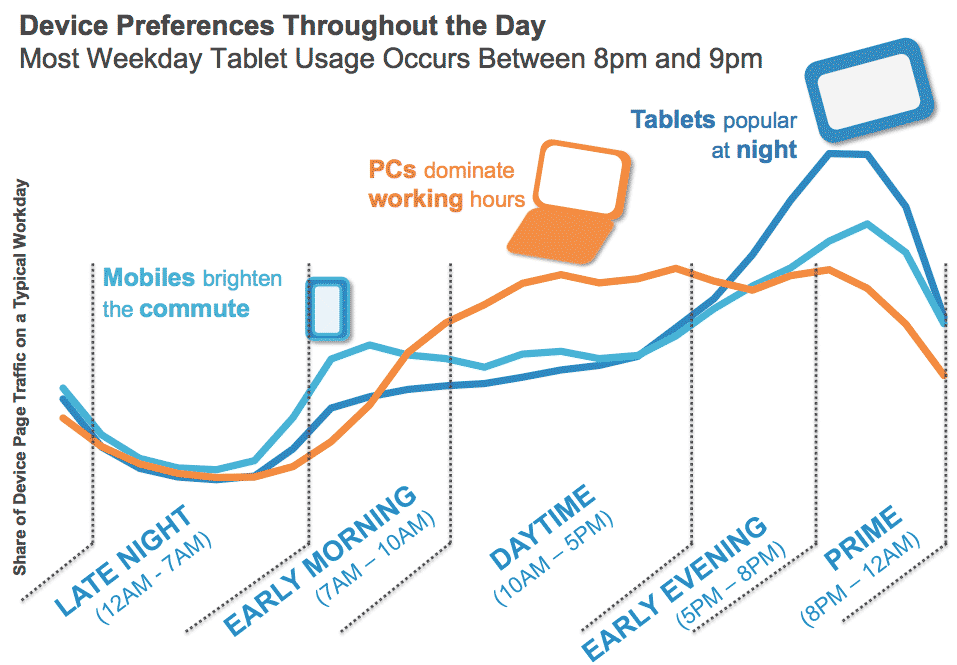With over 11 million monthly visits to digital catalogs made with Publitas, we wondered who are using these publications and how. We dug through a ton of data from February 2014 to compile the most interesting facts and figures around digital catalog usage. When are digital catalogs viewed most? Are they used more by men or women? Do digital catalogs perform differently on different device categories? Read on to find out.
Demographics
Gender distribution of digital catalog users
Looking at the pie chart below, it’s easy to see who wins the gender battle when it comes to digital catalog visits; roughly 3 in 5 (61%) of digital catalog visits come from female users.
Visits to digital catalogs based on gender and age
The graph below shows how often different age groups view digital catalogs, and how that differs between men and women. The clear winner here for both males and females is the age group of people aged 25-34. Relatively speaking, the distribution is pretty much the same for both genders, with the only difference being the order of the two age groups with the lowest number of visits. Based on this data, digital publications are least popular amongst men aged 18-24, while for women it’s the age group of 65 and older.
Top 3 interests of digital catalog users
Looking at our stats, the top three interests of people browsing through digital catalogs are:
- Shopping
- News
- Sports
Based on our demographic data, it’s safe to say that digital catalogs are most popular amongst women aged 25-34, who are into shopping, news, and sports.
Geographic data
The Netherlands
At the moment, more than half of our traffic (51%) comes from the Netherlands. We wondered which Dutch cities would be the biggest drivers of digital catalog traffic, so we decided to have a look. Would it be the big cities or the villages we’ve never even heard of?
Without further ado, these were the top 5 cities in the Netherlands with the highest digital catalog usage (expressed as percentages of total traffic):
- Amsterdam (3.09%)
- Rotterdam (2.22%)
- The Hague (2.03%)
- Utrecht (1.34%)
- Amstelveen (1.04%)
Rest of the world
So how about the other 49% of our traffic? We figured you’d want to know, so we compiled a list of the top 10 cities outside the Netherlands with the highest digital catalog usage (expressed as percentages of total traffic):
- Brussels (1.30%)
- Ghent (1.27%)
- Antwerp (1.26%)
- Sofia (1.17%)
- Istanbul (0.98%)
- Moscow (0.94%)
- Belgrade (0.87%)
- Liege (0.78%)
- Bratislava (0.73%)
- Prague (0.62%)
Smartphone vs. tablet vs. desktop, fight!
So we now know who uses digital catalogs most and in which areas they’re really popular, but what about the devices used to browse through these publications? Are online catalogs viewed more on desktops or mobile devices? Which device category has the highest engagement? Do the peak hours differ between smartphones, tablets, and desktops?
Traffic distribution per device category
Despite the buzz around mobile devices, 72% of our total traffic currently comes from desktop computers. This shows that desktops continue to be the preferred device for browsing through digital catalogs, as they have been ever since we built Publitas.
However, that’s not to say that mobile devices aren’t used to browse through online catalogs. Back in November, Internet Retailer wrote about the growth of digital catalog usage on mobile devices using our stats. Although mobile growth seems to have stagnated since then, over a quarter (28%) of our traffic today comes from smartphones and tablets.
Average visit duration for each device category
We were curious to find out whether people spent more time browsing through digital catalogs on one device compared to another, and if the number of pages in a digital publication affected the average time spent.
| Number of pages | Smartphone | Tablet | Desktop | Average visit duration |
|---|---|---|---|---|
| 0 – 10 | 0:03:15 | 0:02:55 | 0:02:11 | 0:02:47 |
| 11 – 20 | 0:04:29 | 0:04:23 | 0:03:00 | 0:03:57 |
| 21 – 40 | 0:03:43 | 0:05:15 | 0:03:27 | 0:04:08 |
| 41+ | 0:04:24 | 0:06:50 | 0:05:31 | 0:05:35 |
| Total average | 0:03:58 | 0:04:51 | 0:03:32 |
Based on this data, we can conclude that, on average:
- Tablet users spend roughly 50% more time browsing through a digital publication than smartphone users and 24% more than desktop users.
- Consumers spend more time viewing digital catalogs with max. 20 pages on their smartphones, while for publications with more than 21 pages they spend more time on tablets.
- Publications with more than 41 pages have the highest (absolute) average visit duration.
Do publication length and device type affect the average pages per visit?
Another question we were hoping to answer was whether the number of pages in a publication and the device used to view digital catalogs had any effect on the average pages per visit.
The average pages per visit per device category are:
- Smartphone: 12
- Tablet: 14
- Desktop: 15
The average pages per visit for each publication length segment is:
- 0-10: 6
- 11-20: 10
- 21-40: 16
- 41+: 23
Based on this data, we can conclude that on average, desktop users view more pages than mobile users. Also, publications with 0-10 pages seem to have the highest percentage of pages viewed. On average, 60% ((6/10)*100) of the publications with 0-10 pages are viewed, which is higher than any of the other publication length segments. This could suggest that more publications with 0-10 pages are viewed completely than publications with more than 10 pages, but further research is required to determine whether this is actually true.
When are digital catalogs viewed most?
Looking at the peak times in February, we saw a number of interesting trends, which have been summarized below.
| Smartphone | Tablet | Desktop | |
|---|---|---|---|
| Peak Time | 12:00 | Mon-Fri: 20:00 Sat-Sun: 10:00 |
None |
| Peak Day(s) | Sunday | Sunday | Monday, Tuesday, Sunday |
The main takeaways here are:
- Smartphones are used on a daily basis around lunch time to browse through digital catalogs.
- There seem to be two peak times during the week for tablets.
- On weekdays (Mondays to Fridays), digital catalog usage peaks around 20:00, which suggests tablets are used more often after dinner. This seems to be in-line with previous research by comScore that suggests tablet usage peaks between 20:00 and 21:00 on weekdays (see Figure 5).
- During the weekend (Saturday and Sunday), however, usage peaks around 10:00.
- Interestingly, there was no consistent peak hour for desktops, as online catalog usage differed per day.
- Digital catalog usage peaked on Sunday for all three device categories. The reason for this could be that most of our customers publish their digital catalogs and online magazines on Sundays.
- Besides Sunday, Monday and Tuesday were also peak days for desktops.

The top browsers, brands, and operating systems (OSs)
As can be seen from the data in Table 3, Android wins the battle for smartphones, with 59% of smartphone traffic coming from Android devices, while iOS devices account for 39%. When it comes to tablets, Apple’s iPad is the clear winner, accounting for 75% of digital catalog visits from tablets.
Google Chrome continues to grow its share on desktops, and this is reflected in our stats as well. Despite this, Internet Explorer remains the top browser on desktops (for now). Perhaps the most interesting finding for desktop usage was that 95% of traffic comes from Windows and only 4% from Macintosh computers.
| Smartphone | Tablet | Desktop | |
|---|---|---|---|
| Top browsers |
|
|
|
| Top brands |
|
|
N.A. |
| Top OSs |
|
|
|
Digital catalog hotspot interaction rates per device category
We believe that, amongst several other KPIs such as average visit duration, number of visits, and pages per visit, the following three metrics stand out in measuring the success of a digital catalog:
- The percentage clicked on link hotspots: This statistic shows the percentage of visits during which a user clicked at least once on a link hotspot. Links are a type of hotspot that allow users to click on an area in the digital catalog to visit a website. Most of our customers use this if they don’t have an online store but want to drive traffic to their homepage, or if they have an online store but their product feed hasn’t been set up correctly (this way they can link to the product page in their online store).
- The percentage clicked on product hotspots: This statistic shows the percentage of visits during which a user clicked at least once on a product hotspot. Products are a type of hotspot that allow users to click on an area in the digital catalog to receive additional product details (e.g. description, price, extra images, etc.), and include a call-to-action button so users can buy items from your online store.
- The percentage clicked through to online store: This statistic shows the percentage of visits during which a user clicked at least once on the call-to-action button in a product hotspot. In other words, this percentage is a measure of the visits clicking through to your online store to purchase your products.
What’s interesting to see here is that the interaction with product hotspots is much higher than link hotspots. The reason for this could be that product hotspots are an easy way to instantly gather more information about a product, without having to open a new tab in your browser (as is the case with link hotspots). Also, visits from desktops tend to click significantly more on the call-to-action button to the online store than visits from mobile devices. We’re not exactly sure why that is, so that’s something we could look into for future research.
Conclusion and tweetables
We hope this post gave you a better understanding of how our digital catalogs are used. If you have other stats that you’d like to read more about, let us know so we can answer your questions in a future post.
Also, if you enjoyed this article, we’d really appreciate if you shared it on your social accounts. Here are some stats that you could share along with this article:
- ⅗ digital catalog users are females aged 25-34.
- ⅖ digital catalog users males aged 25-34.
- Digital catalogs are most popular amongst women aged 25-34.
- Top 3 interests of digital catalog users are shopping, news, and sports.
- Top 3 cities in the Netherlands with the highest digital catalog usage are Amsterdam, Rotterdam, and The Hague.
- 72% of digital catalog traffic comes from desktops, 17% from tablets, and 11% from smartphones.
- 28% of digital catalog traffic comes from mobile devices.
- Tablet users spend 50% more time going through online catalogs than smartphone users & 24% more than desktop users.
- Digital catalog usage on smartphones peaks around lunch time.
- Digital catalog usage on tablets peaks around 20:00 during weekdays and around 10:00 in the weekend.
- Consumers prefer to browse through digital catalogs on Sundays.


